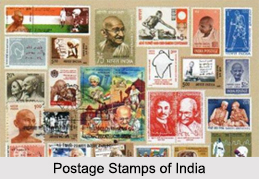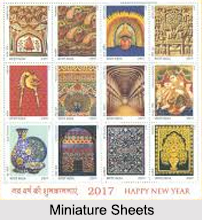 Long before the introduction of postage stamps, the history of Indian Postal Service dates back to the ancient medieval Indian era. It was during the reign of the British East India Company that the Indian Postal Service started to proliferate and postage stamps were introduced. The postage stamps of India have been produced by a variety of techniques including line engraving, typography, lithography, photogravure and web- offset.
Long before the introduction of postage stamps, the history of Indian Postal Service dates back to the ancient medieval Indian era. It was during the reign of the British East India Company that the Indian Postal Service started to proliferate and postage stamps were introduced. The postage stamps of India have been produced by a variety of techniques including line engraving, typography, lithography, photogravure and web- offset.
Postage Stamps of India during British Rule
In 1840, world"s first adhesive postage stamp called the Penny Black was first issued in England and 12 years later in 1852, the Scinde Dawks were issued. This was the first adhesive postage stamp in Asia that was issued in the Indian district of Scinde by Bartle Frere, the chief commissioner of the region. Frere was fond of the works of Rowland Hills, the English postal reformer, who had introduced the Penny Black. The Scinde Dawks, which was an Anglicised spelling of the word Dak meaning post, were issued with a value of ½ anna and were in use until June 1866.
The first all- India stamps were issued on 1st October, 1854 and from that period on till 1866, the volume of mail moved by the postal system increased significantly, which was again doubled in 1871. In 1866, India was the first country to adopt the expedient of overprinting "Service" on postage stamps and "Service Postage" on revenue stamps. This innovation was later widely adopted by other countries. In the same year, new designs for the 4 anna and 6 anna 8 pie stamps were issued. This improvisation of postage stamps was due to shortages and some "Service Postage" overprinted rarities resulted from abrupt changes in postal regulations. The provisional 6 anna stamps were improvised by cutting the top and bottom from a current foreign-bill revenue stamp and overprinting "Postage".
 Post- Independence Postage Stamps of India
Post- Independence Postage Stamps of India
After the Indian Independence, the Indian Posts and Telegraph Department embarked on a broad based policy for the issuance of stamps. Post- Independence, the first stamp was issued on 21st November, 1947 which depicted the Indian National Flag with the patriot"s slogan, "Jai Hind" (long live India), at the top right corner of the stamp.
A year later in 1948, a memorial to Mahatma Gandhi was issued on the first anniversary of independence and consequently another year later, there was an introduction of a definitive series. This series portrayed the broader cultural aspects of India, primarily the Hindu, Buddhist, Muslim, Sikh and Jain temples, sculptures, monuments and fortresses. Subsequent issues commemorated the beginning of the Republic of India in 1950 and other variations like the series that depicted the map of India in 1957 and the wide variety of images of 1965 were also part of the postage stamps of post- Independent India.
Till 1957, the stamps issued continued to be in annas, which changed when the Indian rupee was decimalised. The change in currency is reflected in the denomination of the stamps of the time. The initial stamps were commemorative or special issues. In 1949 the first definitive Archaeological series of 16 values was issued.
List of Postage Stamps of India
Currently, there are 6 types of postage stamps in circulation in India and they are follows:
Commemorative Stamps: Issued as a remembrance or to honour a significant date such as an anniversary, or to honour a place, event, person or object, the Commemorative Stamps celebrate special events or famous public personalities. There are numerous Commemorative Stamps, whose subjects always showcase a vibrant India. The subjects of the Commemorative Stamps are usually spelled out in print. These stamps celebrate freedom fighters, politicians, along with sports, space, science and technology, defence, arts and crafts etc.
 Republic Definitive Stamps: The Republic Definitive Stamps are a part of the regular issue and are available for using postage services for an extended period of time. Serves for regular use, these stamps are a part of the everyday postal needs of the country. A definitive issue or series have a range of denominations sufficient to cover ongoing postal rates. Several definitive stamps of India have been issued with different themes and illustrations, depicting art, history, science & technology, nature, vehicles, industries, institutions and more.
Republic Definitive Stamps: The Republic Definitive Stamps are a part of the regular issue and are available for using postage services for an extended period of time. Serves for regular use, these stamps are a part of the everyday postal needs of the country. A definitive issue or series have a range of denominations sufficient to cover ongoing postal rates. Several definitive stamps of India have been issued with different themes and illustrations, depicting art, history, science & technology, nature, vehicles, industries, institutions and more.
Military Stamps: The Military Stamps are a special type of postage stamps that are issued during the times of peace keeping operations and war. The letters are mostly transported by the army from one desired location to another. The purpose of these Military Stamps was seen during the Second World War, when it was used by the soldiers to send messages to their loved ones. The themes of these stamps showcase different monuments, culture, arts and crafts, personalities and more. The stamps are overprinted to use in foreign on regular definitive stamps by Peace- keeping Armed Forces.
Miniature Sheets: The Miniature Sheets are a small group of stamps that are still attached to the sheet on which they are printed. These stamps could be of regular or commemorative use as well and could be of individual designs as well with special illustrations on the sheet. Over the centuries, India has issued several Miniature Sheets, which portrays different aspects of the nation"s identity like famous personalities, important events, art and culture, history, monuments etc.
Se-tenant Stamps: Printed on the same plate, the Se-tenant Stamps makes a set which adjoins each other on the same sheet. But their designs, colour, denominations or overprint differ. Indian is known to release some of the most aesthetically beautiful Se-tenant Stamps that are famous around the world and are a collector"s dream to own.
My Stamp: The brand name for personalized sheets of postage stamps of India Post, My Stamp was first introduced in India during the World Philatelic Exhibition, "INDIPEX 2011". The My Stamp personalization is achieved by printing a thumb nail image of the individual photograph and logos of institutions, or images of artwork, heritage buildings, famous tourist places, historical cities, wildlife, other animals and birds etc., on a selected template sheet having postage stamps.















